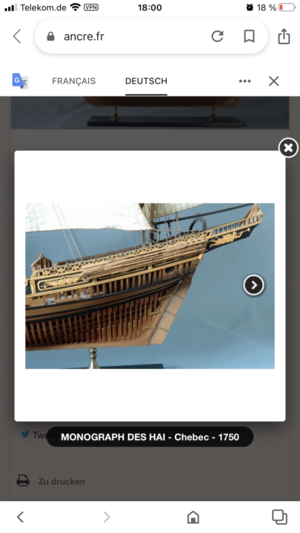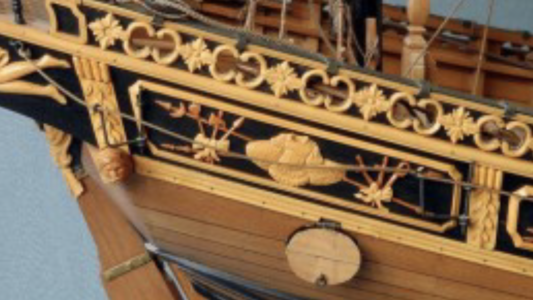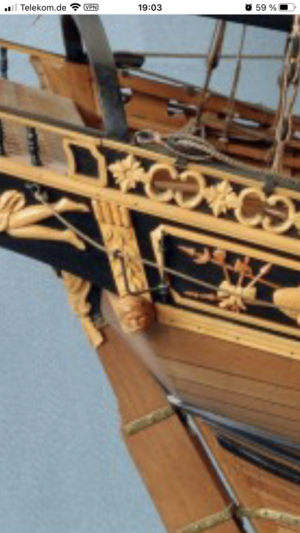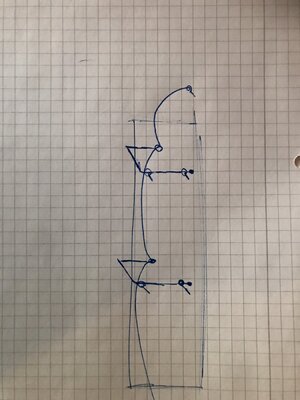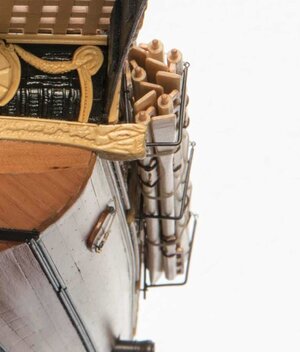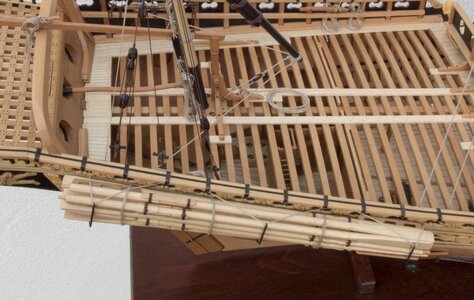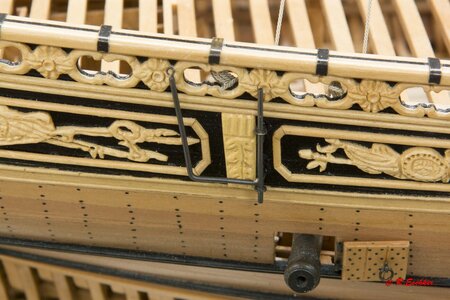Last night I downloaded a research paper whose title included "Lead weights associated with wood". It presented findings off of the Israel coast for Bronze Age wrecks where lead sheet and trapizoidal items were recovered. Analysis concluded that they were used with long oars by the handle section to offset the oar outboard weight. Two types: a sheet with engravings wrapped around the oar itself and with nail holes for speculated copper nails. Second was a cast trapazoid with a depression on one side to fit on the side or bottom of an oar. It makes sense as long oars would be heavy in themselves with most of the weight outboard when in the recovery phase of each stroke. Interesting but logical. Rich (PT-2)Finalizing the oars
Comparing with the Boudriot drawing of the Le Coureur
View attachment 257359
- after some time of carefully sanding I finished all eight oars
View attachment 257353
View attachment 257354
View attachment 257355
View attachment 257352
View attachment 257356
I have to state, that CAF prepared for the kit really very good timber - for parts like these oars you finaly realize how important is a good timber you are working.
The oars are flexible and you can bend them without braking or cracking, the grain is running exactly along the length of the oars, so no problems at all during sanding and preparation - Bravo @CAFmodel for such a kit
At the end of this post -> PULL - PULL - PULL
View attachment 257357
View attachment 257358
-

Win a Free Custom Engraved Brass Coin!!!
As a way to introduce our brass coins to the community, we will raffle off a free coin during the month of August. Follow link ABOVE for instructions for entering.
- Home
- Forums
- Ships of Scale Group Builds and Projects
- Le Coureur 1776 1:48 PoF Group Build
- Le Coureur 1776 1:48 Group Build Logs
You are using an out of date browser. It may not display this or other websites correctly.
You should upgrade or use an alternative browser.
You should upgrade or use an alternative browser.
LE COUREUR - french Lugger 1776 - POF kit from CAF in 1:48 by Uwe
Oh Ja - Mon Ami -> You are WRONG!Sorry, Mon Ami, unless the tug boat is attached from the port-side (no visible), I don't see how this small motorboat can pull Hermione. If you look closely, you will not see any tow-cables attached. Also, given that she has some sails 'ON', she might sail on her own, IMHO.But...I could be wrong...
The Hermione is very special - she has a diesel motor, but a very small one only to manouevre and in very special emergency cases. They are not using the motor for sailing - it is somply not possible, because it is too small.
Her sails shown in the photo are only for show or already prepared, when she is reaching the open sea.
Here you can see the river and the city with the harbor (red arrow)
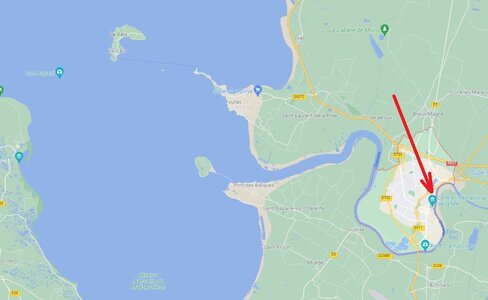
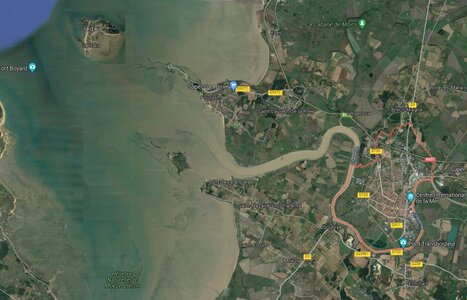
I guess you understand, that sailing with sails will be not possible on such a river over the distance. I remember from my visit there some years ago, that the guide told us, that ships sometimes needed more than one day to pass the distance
And here, that you really believe me
take a close look at the small red dott
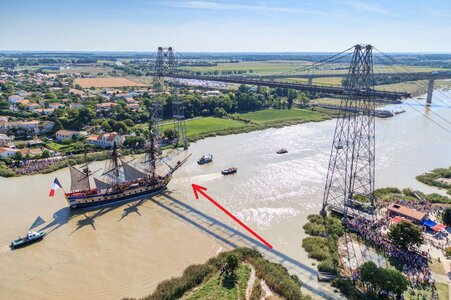
and here you can see the "dott" better
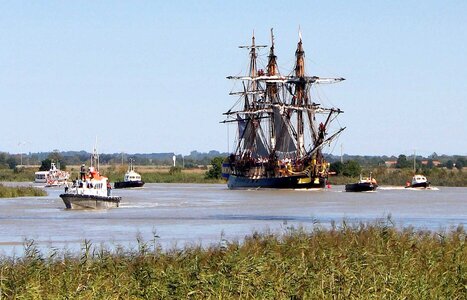
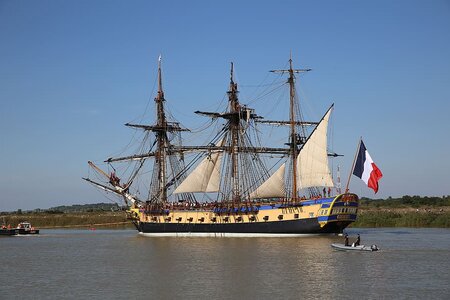
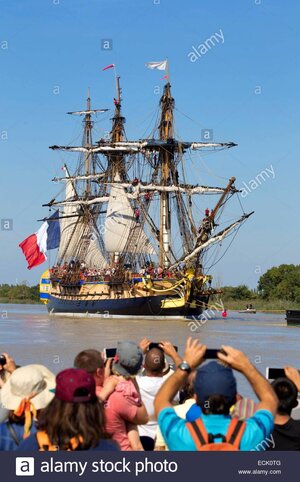
Hi Uwe!
I found a picture of the french marine draftsman "Ozanne".
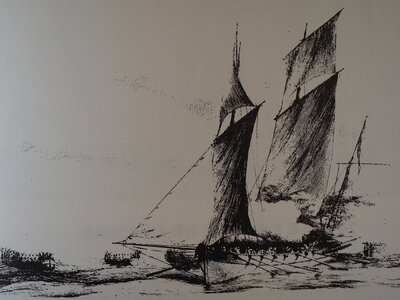
Capture of an english lugger during a calm on august 15, 1779. The canoes and sloops of the frigates l'Athalante and Sainte-Catherine approach the lugger which is too slow with its oars. A part of the English crew is already reduced by musket shots and then the ship is boarded.
Best regards
Thomas
I found a picture of the french marine draftsman "Ozanne".

Capture of an english lugger during a calm on august 15, 1779. The canoes and sloops of the frigates l'Athalante and Sainte-Catherine approach the lugger which is too slow with its oars. A part of the English crew is already reduced by musket shots and then the ship is boarded.
Best regards
Thomas
Last edited:
Her some photos of my day trip on the river, Fort Boyard and island Île-d'AixOh Ja - Mon Ami -> You are WRONG!
The Hermione is very special - she has a diesel motor, but a very small one only to manouevre and in very special emergency cases. They are not using the motor for sailing - it is somply not possible, because it is too small.
Her sails shown in the photo are only for show or already prepared, when she is reaching the open sea.
Here you can see the river and the city with the harbor (red arrow)
View attachment 257525 View attachment 257526
I guess you understand, that sailing with sails will be not possible on such a river over the distance. I remember from my visit there some years ago, that the guide told us, that ships sometimes needed more than one day to pass the distance
And here, that you really believe me
take a close look at the small red dott
View attachment 257523
and here you can see the "dott" better
View attachment 257524
View attachment 257522
View attachment 257521
INTERNATIONAL CONVENTION OF MODEL SHIPBUILDING - Rochefort, France - 18.th-21.st October 2018
During these days in Rochefort we had also the possibility to visit some naval highlights of the city. We visited the Maritime museum, the replica of the frigate Hermione and also the Air Command museum. Detailed photo reports you can find here: Marine Museum Rochefort, France - MUSÉE DE LA...
shipsofscale.com
At the time of this post I wrote:
along the river - during the time of sailing it took appr. one week for the Ships of Line to travel between Rochefort harbour to the open sea
Great findHi Uwe!
I found a picture of the french marine draftsman "Ozanne".
View attachment 257534
Capture of an english lugger during a calm on august 15, 1779. The canoes and sloops of the frigates l'Athalante and Sainte-Catherine approach the lugger which is too slow with its oars. A part of the English crew is already reduced by musket shots and then the ship is boarded.
Best regards
Thomas
- we can see, that the english lugger also had only 5 oars on each side in use - and still some oars stored aft alongside the hull .....
Boudriot is writing in his monograph:
the oars are 35 feet in length and operated by four men. There are 9 crotches on each side, but the vessel cannot be fitted with all oars out at the same time due to lack of crewmembers
and he is also writing
The oars are stored either on the deck against the ship´s boat or alongside the hull in iron crotches fitted towards the stern.....
After I finished the 8 oars content in the kit, I was able to check, how it is looking when the oars will be stored on the deck - here you can see, that the oars a really long compared to the vessel they belong to.....
when there are also the four guns installed and the boat and maybe the spare anchor ...... I think the deck will be very crowdy
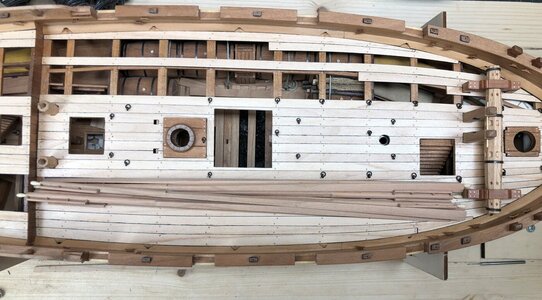
So let us once more take a look inside the Boudriot monograph of the Le Coureur
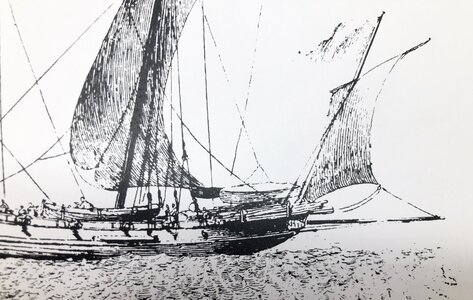
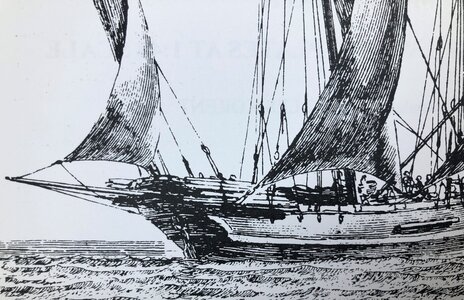
We can find these two contemporary illustrations showing the oars stored alongside the hull in iron crotches fitted towards the stern.
So I think, this will be the way of presentation (if I will add the oars to the model)
With some brass wire I made fastly some loops and added the oars, only to see how it will look like
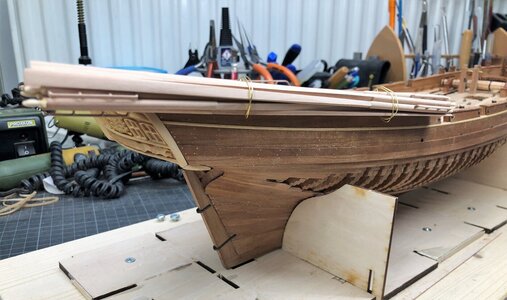
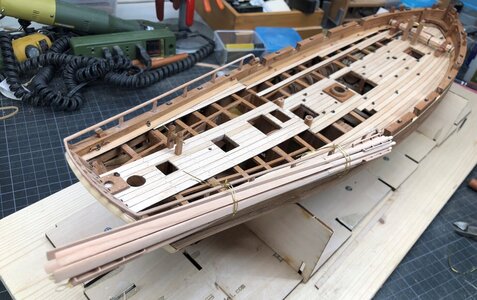
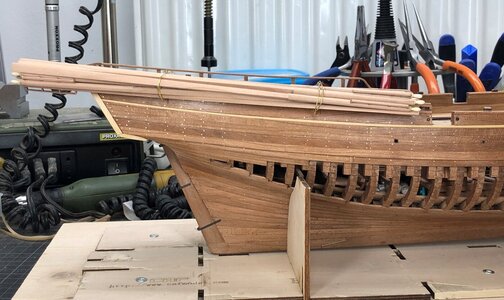
these oars are really looooong
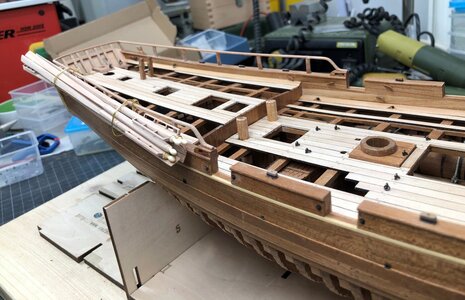
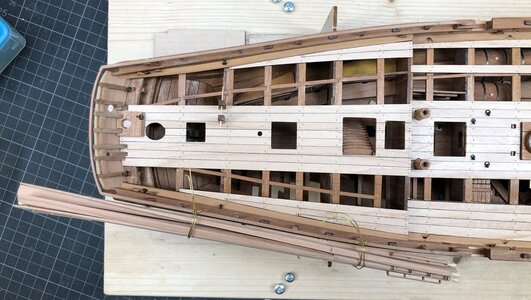
Hmmmmm .... I will see at the end, when the masts, spars and sails are added how it will look like ....
.... also the question to the members watching this building log -> What do you think?
BTW:
We have now reached more than 1.000 posts in this building log -
Many Thanks to all of you having interest in my work, following and / or commenting in this topic
Also off course for all the likes received
the oars are 35 feet in length and operated by four men. There are 9 crotches on each side, but the vessel cannot be fitted with all oars out at the same time due to lack of crewmembers
and he is also writing
The oars are stored either on the deck against the ship´s boat or alongside the hull in iron crotches fitted towards the stern.....
After I finished the 8 oars content in the kit, I was able to check, how it is looking when the oars will be stored on the deck - here you can see, that the oars a really long compared to the vessel they belong to.....
when there are also the four guns installed and the boat and maybe the spare anchor ...... I think the deck will be very crowdy

So let us once more take a look inside the Boudriot monograph of the Le Coureur


We can find these two contemporary illustrations showing the oars stored alongside the hull in iron crotches fitted towards the stern.
So I think, this will be the way of presentation (if I will add the oars to the model)
With some brass wire I made fastly some loops and added the oars, only to see how it will look like



these oars are really looooong


Hmmmmm .... I will see at the end, when the masts, spars and sails are added how it will look like ....
.... also the question to the members watching this building log -> What do you think?
BTW:
We have now reached more than 1.000 posts in this building log -
Many Thanks to all of you having interest in my work, following and / or commenting in this topic
Also off course for all the likes received
I think its a good idea because its not a commonly detail. Interesting !
- Joined
- Sep 3, 2021
- Messages
- 5,145
- Points
- 738

Dear Uwek,Boudriot is writing in his monograph:
the oars are 35 feet in length and operated by four men. There are 9 crotches on each side, but the vessel cannot be fitted with all oars out at the same time due to lack of crewmembers
and he is also writing
The oars are stored either on the deck against the ship´s boat or alongside the hull in iron crotches fitted towards the stern.....
After I finished the 8 oars content in the kit, I was able to check, how it is looking when the oars will be stored on the deck - here you can see, that the oars a really long compared to the vessel they belong to.....
when there are also the four guns installed and the boat and maybe the spare anchor ...... I think the deck will be very crowdy
View attachment 257547
So let us once more take a look inside the Boudriot monograph of the Le Coureur
View attachment 257545
View attachment 257546
We can find these two contemporary illustrations showing the oars stored alongside the hull in iron crotches fitted towards the stern.
So I think, this will be the way of presentation (if I will add the oars to the model)
With some brass wire I made fastly some loops and added the oars, only to see how it will look like
View attachment 257548
View attachment 257549
View attachment 257552
these oars are really looooong
View attachment 257550
View attachment 257551
Hmmmmm .... I will see at the end, when the masts, spars and sails are added how it will look like ....
.... also the question to the members watching this building log -> What do you think?
BTW:
We have now reached more than 1.000 posts in this building log -
Many Thanks to all of you having interest in my work, following and / or commenting in this topic
Also off course for all the likes received
First my compliments about the oars, all hand sanded, I understood?
When looking at your trial oar installation, I wondered whether or not they would have the oars in two groups of four on either side of the hull. Is there any historical evidence for that assumption?
Kind regards,
Johan
Hallo Uwe, I agree with Oliver, this is not a common representation and therefore quite an interesting one. Looking at Boudriots drawings, the oars are probably attached to both sides. So as Johan correctly recognized, on each side 4. Then the whole thing does not look so bulky. It looks more elegant.I think its a good idea because its not a commonly detail. Interesting !
Kurt Konrath
Kurt Konrath
The drawing shows what I think would be logical that oars be split into two groups and hung half on each side for balance and to reduce bulk in each group.Boudriot is writing in his monograph:
the oars are 35 feet in length and operated by four men. There are 9 crotches on each side, but the vessel cannot be fitted with all oars out at the same time due to lack of crewmembers
and he is also writing
The oars are stored either on the deck against the ship´s boat or alongside the hull in iron crotches fitted towards the stern.....
After I finished the 8 oars content in the kit, I was able to check, how it is looking when the oars will be stored on the deck - here you can see, that the oars a really long compared to the vessel they belong to.....
when there are also the four guns installed and the boat and maybe the spare anchor ...... I think the deck will be very crowdy
View attachment 257547
So let us once more take a look inside the Boudriot monograph of the Le Coureur
View attachment 257545
View attachment 257546
We can find these two contemporary illustrations showing the oars stored alongside the hull in iron crotches fitted towards the stern.
So I think, this will be the way of presentation (if I will add the oars to the model)
With some brass wire I made fastly some loops and added the oars, only to see how it will look like
View attachment 257548
View attachment 257549
View attachment 257552
these oars are really looooong
View attachment 257550
View attachment 257551
Hmmmmm .... I will see at the end, when the masts, spars and sails are added how it will look like ....
.... also the question to the members watching this building log -> What do you think?
BTW:
We have now reached more than 1.000 posts in this building log -
Many Thanks to all of you having interest in my work, following and / or commenting in this topic
Also off course for all the likes received
But I think the oars are a good fit on aft side of hull, stored out of way for use when needed.
Having the oars stowed on the outboard sides aft is, as Oliver mentioned, a very interesting detail.
As others have said it would also make sense for an equal number of oars to be placed both sides. The oars were no doubt difficult to deploy when needed so having them ready each side would make handling easier for the crew.
The book “The Sailing Frigate“ by Robert Gardiner has, on pages 98-101 some information and details on the use of oars. There is some discussion on if, and when, oars would be carried.
So if you are sending your excellent model to war in the Americas to fight, then as you say, you need room for your cannons on deck. Which means securing the oars in the crutches each side aft.
I wonder also, in expected heavy weather and high seas, if they moved the oars from the outboard sides of the ship onto the main-deck?
As others have said it would also make sense for an equal number of oars to be placed both sides. The oars were no doubt difficult to deploy when needed so having them ready each side would make handling easier for the crew.
The book “The Sailing Frigate“ by Robert Gardiner has, on pages 98-101 some information and details on the use of oars. There is some discussion on if, and when, oars would be carried.
So if you are sending your excellent model to war in the Americas to fight, then as you say, you need room for your cannons on deck. Which means securing the oars in the crutches each side aft.
I wonder also, in expected heavy weather and high seas, if they moved the oars from the outboard sides of the ship onto the main-deck?
Last edited:
Many thanks to @Olivers Historic Shipyard , @RDN1954 ,@pianoforte, @Kkonrath and @RogerD for your comments, hints and opinions.
And I guess you are right to install finaly alongside near the stern on both sides.
I tried first to put the 8 kit-oars to only one side, because Boudriot was writing that the ship had more oars on board, but too less seaman to handle all of them.
I guess I will stick with the 8 oars from the kit (but maybe Tom from @CAFmodel will provide me one more set of oars) and will stor them on each side four pcs.
I just made a small test with some wire, in order to see how it will look like - so here 2 times 4 oars
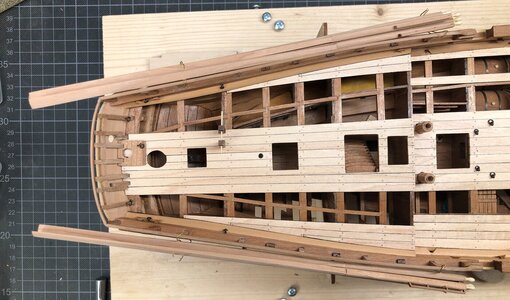
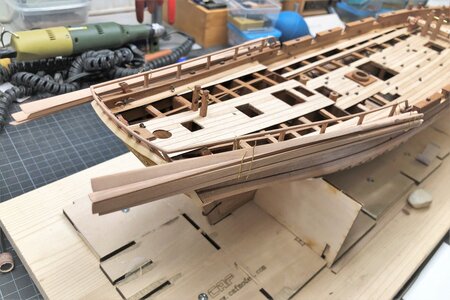
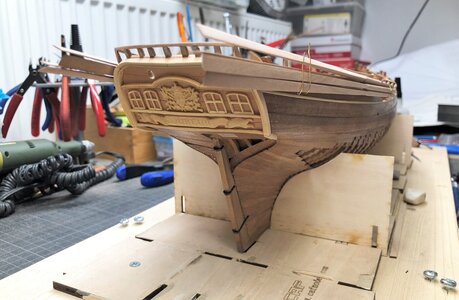
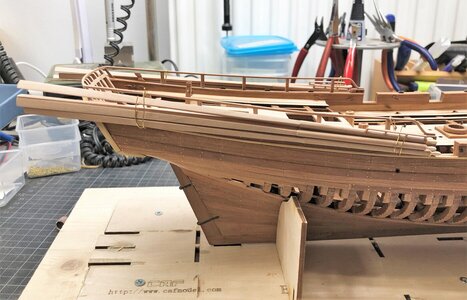
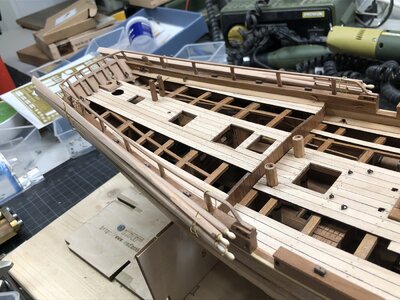
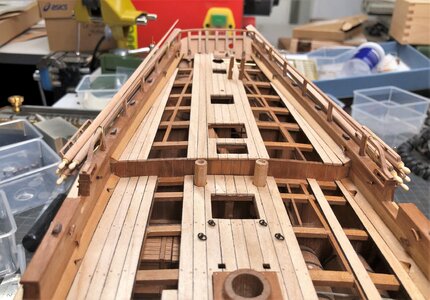
With the small number of oars on each side it is also much easier to store them in such a way, that the oars have all the same direction, means on the fore end are every time the handles and aft the blades - with more oars together I guess they would have to be mixed in order to get a "good package"
Is somebody knows or has a sketch / photo how such cages / iron crotches (according Boudriot) are looking like and were fixed to the ship ..... would be great to see - otherwise I have to think by myself how they could look like and would work, also in heavy seas etc. Boudriot has no information at all in the monograph of the Le Coureur...... but first I will check “The Sailing Frigate“ by Robert Gardiner like Roger mentioned, and also the monograph of the LE REQUIN - thanks to Tobias for the hint
And I guess you are right to install finaly alongside near the stern on both sides.
I tried first to put the 8 kit-oars to only one side, because Boudriot was writing that the ship had more oars on board, but too less seaman to handle all of them.
I guess I will stick with the 8 oars from the kit (but maybe Tom from @CAFmodel will provide me one more set of oars) and will stor them on each side four pcs.
I just made a small test with some wire, in order to see how it will look like - so here 2 times 4 oars






With the small number of oars on each side it is also much easier to store them in such a way, that the oars have all the same direction, means on the fore end are every time the handles and aft the blades - with more oars together I guess they would have to be mixed in order to get a "good package"
Is somebody knows or has a sketch / photo how such cages / iron crotches (according Boudriot) are looking like and were fixed to the ship ..... would be great to see - otherwise I have to think by myself how they could look like and would work, also in heavy seas etc. Boudriot has no information at all in the monograph of the Le Coureur...... but first I will check “The Sailing Frigate“ by Robert Gardiner like Roger mentioned, and also the monograph of the LE REQUIN - thanks to Tobias for the hint
- Joined
- Sep 3, 2021
- Messages
- 5,145
- Points
- 738

The four oars each side option is for me the most appealing. Having said that; above all, it's your build!Many thanks to @Olivers Historic Shipyard , @RDN1954 ,@pianoforte, @Kkonrath and @RogerD for your comments, hints and opinions.
And I guess you are right to install finaly alongside near the stern on both sides.
I tried first to put the 8 kit-oars to only one side, because Boudriot was writing that the ship had more oars on board, but too less seaman to handle all of them.
I guess I will stick with the 8 oars from the kit (but maybe Tom from @CAFmodel will provide me one more set of oars) and will stor them on each side four pcs.
I just made a small test with some wire, in order to see how it will look like - so here 2 times 4 oars
View attachment 257714
View attachment 257715
View attachment 257716
View attachment 257717
View attachment 257718
View attachment 257719
With the small number of oars on each side it is also much easier to store them in such a way, that the oars have all the same direction, means on the fore end are every time the handles and aft the blades - with more oars together I guess they would have to be mixed in order to get a "good package"
Is somebody knows or has a sketch / photo how such cages / iron crotches (according Boudriot) are looking like and were fixed to the ship ..... would be great to see - otherwise I have to think by myself how they could look like and would work, also in heavy seas etc. Boudriot has no information at all in the monograph of the Le Coureur...... but first I will check “The Sailing Frigate“ by Robert Gardiner like Roger mentioned, and also the monograph of the LE REQUIN - thanks to Tobias for the hint
Hello Tobias, those pictures really show the stowage arrangements well.
A mix of “crutches” and lashings, which makes a lot of sense really.
A mix of “crutches” and lashings, which makes a lot of sense really.
Good pictures are worth a thousand words! Rich
I am happy to see pictures from my own Le Requien. In the appendix you can see the mounting of the oars on my model.
Many Many thanks to Rüdiger Eschker alias @Lucius showing us this detail made on his amazing model of the Le Requin he built some years ago.
Before I come to the cage for the oars I want to give you all the link to the web-page showing much more photos of the finished model - Take a look and enjoy
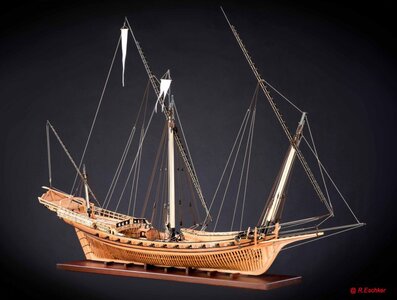
If you are interested also in the construction of his model, please take a look at his building log (in german language) in the german forum:

Baubericht » Le Requin 1750
Hallo liebe Mitstreiter, Nach reichlicher Überlegung und mancher Enttäuschung betreffend meiner Bauberichte im Forum Bolitho (war alles über Na
 www.segelschiffsmodellbau.com
www.segelschiffsmodellbau.com
BTW: In a private communication with Rüdiger I got the acceptance to use his photos here in our forum - many thanks once more






